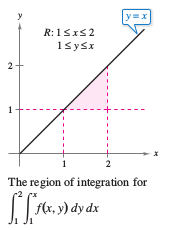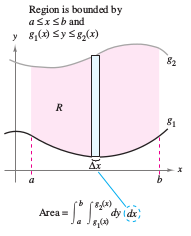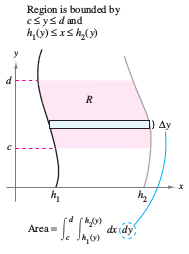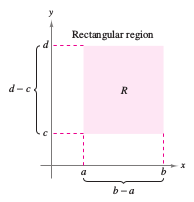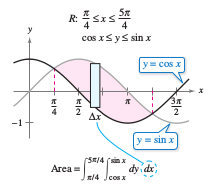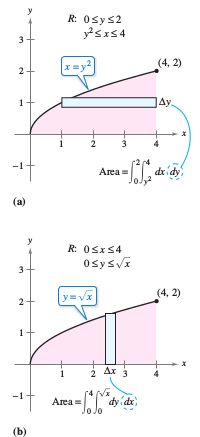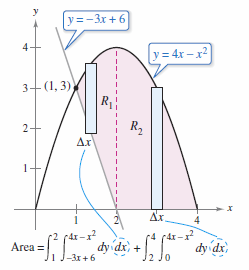Calculus III 14.01 Iterated Integrals and Area in the Plane
| Previous | Calculus III 13 Functions with Several Variables |
| Next | Calculus III 14.02 Double Integrals and Volume |
Contents
14.01 Iterated Integrals and Area in the Plane
- Evaluate an iterated integral.
- Use an iterated integral to find the area for a plane region.
Iterated Integrals
An iterated integral is a method to apply integrals to a function with multiple variables. Chapter 13 described differentiating functions with multiple variables by differentiating with respect to one variable while holding the others constant. Integrating functions with multiple variables can be done in the same way.
Consider the partial derivative \(f_{x}(x,y)=2xy\). By holding \(y\) constant integration can be done with respect to \(x\) to produce
| $$ f(x,y)$$ | $$= \int f_{x}(x,y)\:dx \:\:\:\:$$ | Integrate with respect to \(x\). |
| $$= \int 2xy \:dx $$ | Hold \(y\) constant. | |
| $$=y \int 2x \: dx $$ | Factor out constant \(y\). | |
| $$=y(x^{2}) + C(y) $$ | Antiderivative for \(2x\) is \(x^{2}\). | |
| $$=x^{2}y +C(y) $$ | \(C(y)\) is a function for \(y\). |
The constant for integration, \(C(y)\), is a function for \(y\). By integrating with respect to \(x\), \(f(x,y)\) is only partially recovered. The total recover for a function, \(f(x,y)\), is described in Chapter 15.
By considering \(y\) constant the Fundamental Theorem of Calculus can be applied to evaluate
| $$ \int_{1}^{2y} 2xy \: \color{red}{dx} $$ | $$= \left. \vphantom{\int_{1}^{2y}} x^{2}y \right]_{1}^{2y}$$ | \(x\) is the integration variable and \(y\) is fixed. |
| \(= (\color{red}{2y})^{2}y-(\color{red}{1})^{2}y \:\:\:\: \) | \(x\) is the integration variable and \(y\) is fixed. | |
| \(=4y^{3}-y\) | The result is a function for \(y\) |
The procedures for integrating with respect to \(x\) and \(y\) are:
| $$ \left. \int_{h_{1}(y)}^{h_{2}(y)} f_{x}(x,y) \: dx = f(x,y) \right ]_{h_{1}(y)}^{h_{2}(y)} = f(h_{2}(y),y) -f(h_{1}(y),y) \:\:\:\: $$ | With respect to \(x\) |
| $$ \left. \int_{g_{1}(x)}^{g_{2}(x)} f_{y}(x,y) \: dy = f(x,y) \right ]_{g_{1}(x)}^{g_{2}(x))} = f(x,g_{2}(x)) -f(x,g_{1}(x))$$ | With respect to \(y\) |
Note the integration variable cannot appear in either integration limit. For instance, it makes no sense to write
- $$ \int_{0}^{x} y \: dx. $$
Example 14.1.1 Integration with Respect to \(y\)
Evaluate
- $$ \int_{1}^{x} (2x^{2}y^{-2} + 2y) \: dy.$$
Solution Holding \(x\) as a constant and integrating with respect to \(y\) produces
| $$ \int_{1}^{x} (2x^{2}y^{-2} + 2y) \: dy $$ | $$= \left [ \frac{-2x^{2}}{y} + y^{2} \right ]_{1}^{x} $$ |
| $$= \left( \frac{-2x^{2}}{x} + x^{2} \right ) - \left ( \frac{-2x^{2}}{1} + 1 \right )$$ | |
| $$= 3x^{2} - 2x - 1. $$ |
Note the integral defines a function for \(x\) that can itself be integrated, as shown in Example 14.1.2.
Example 14.1.2 Double Integral
Evaluate
- $$ \int_{1}^{2} \left [ \int_{1}^{x} (2x^{2}y^{-2} + 2y)\: dy \right ]\: dx.$$
Solution Using the result from Example 14.1.1,
| $$ \int_{1}^{2} \left [ \int_{1}^{x} (2x^{2}y^{-2} + 2y)\: dy \right ]\: dx $$ | $$= \int_{1}^{2} (3x^{2}-2x-1)\: dx $$ | |
| $$= \left [ \vphantom{\frac{1}{2}} x^{3}-x^{2}-x \right]_{1}^{2} $$ | Integrate with respect to \(x\). | |
| $$= 2-(-1) = 3. $$ |
|
|
The integral in Example 14.1.2 is an iterated integral. The square brackets used are normally not written, but described as
The inside limits of integration can be variable with respect to the outer integration variable. However, the outside limits of integration must be constant with respect to both integration variables. After performing the inside integration a “standard” definite integral is produced. The second integration produces a real number. The integration limits for an iterated integral identify two boundary sets, one for each variable set. Consider Example 14.1.2, the outside limits indicate that \(x\) lies in the interval \(1 \leqslant x \leqslant 2\) and the inside limits indicate that \(y\) lies in the interval \(1 \leqslant y \leqslant x \). The intervals combine to describe the region of integration \(R\) for the integrated integral, as shown in Figure 14.1.1. Because an iterated integral is just a definite integral special type -- one in which the integrand is also an integral -- the properties for definite integrals are used to evaluate iterated integrals. |
Area for a Plane Region
|
|
The area for a plane region can be found using integrated integrals. Consider the plane region \(R\) bounded by \(a \leqslant x \leqslant b\) and \(g_{1}(x) \leqslant y \leqslant g_{2}(x)\), as shown in Figure 14.1.2. The area for \(R\) is
Using the Fundamental Theorem of Calculus the integrand \(g_{2}(x) - g_{1}(x)\) can be written as a definite integral. Consider \(x\) fixed and let \(y\) vary from \(g_{1}(x)\) to \(g_{2}(x)\). The result is
Region \(R\)'s area can be described by combining the two integrals into an iterated integral
Placing a representative rectangle in the region \(R\) helps determine both the order and the integration limits. A vertical rectangle implies the order \(dy\: dx\), with the inside limits corresponding to the upper and lower rectangle bounds, as shown in Figure 14.1.2. The region is vertically simple to integrate because the outside limits represent the vertical lines
and
A horizontal rectangle implies the order \(dx \: dy\), with the inside limits determined by the left and right rectangle edges, as shown in Figure 14.1.3. The region is horizontally simple, because the outside limits represent the horizontal lines
and
|
Theorem 14.1.1 Area for a Region in a Plane
| 1. | If \(R\) is defined by \(a \leqslant x \leqslant b\) and \(g_{1}(x) \leqslant y \leqslant g_{2}(x)\), where \(g_{1}\) and \(g_{2}\) are continuous on \([a,b]\), then the area for \(R\) is
$$A = \int_{a}^{b} \int_{g_{1}(x)}^{g_{2}(x)} dy \: dx. \:\:\:\: \color{red}{ \text{Figure 14.1.2 (vertically simple)}} $$ |
| 2. | If \(R\) is defined by \(c \leqslant y \leqslant d\) and \(h_{1}(y) \leqslant x \leqslant h_{2}(y)\), where \(h_{1}\) and \(h_{2}\) are continuous on \([c,d]\), then the area for \(R\) is
$$A = \int_{c}^{d} \int_{h_{1}(y)}^{h_{2}(y)} dx \: dy. \:\:\:\: \color{red}{ \text{Figure 14.1.3 (horizontally simple) }}$$ |
If all four integration limits are constants, then the integration region is rectangular, as shown in Example 14.1.3.
Example 14.1.3 Rectangular Region Area
|
|
Use an iterated integral to represent the area for the rectangle shown in Figure 14.1.4
Note the answer is consistent with conventional Euclidean Geometry. |
Example 14.1.4 Finding Area by an Iterated Integral
|
|
Use an iterated integral to find the area for the region bounded by the graphs
and
between \(x=\pi/4\) and \(x=5 \pi/4\).
Because the rectangle is bounded above by \(f(x)=\sin x\) and below by \(g(x)= \cos x\) the area is
|
The integration region for an iterated integral need not have any straight lines as boundaries. Figure 14.1.5 shows an integration region that is vertically simple even though it has no vertical lines as left and right boundaries. The region is vertically simple is because it is bounded above and below by the graphs for functions of \(x\).
One integration order will often produce a simpler integration problem than the other order. For instance, try reworking Example 14.1.4 with the order \(dx \: dy\) makes the task formidable, but with the same answer. In other words, the integration order affects the integration's difficulty, but not the result.
Example 14.1.5 Comparing Different Integration Orders
|
|
Sketch the region whose area is represented by the integral
Then find another iterated integral using the order \(dy \: dx\) to represent the same area and show that both integrals yield the same result.
which means the region \(R\) is bounded on the left by the parabola \(x=y^{2}\) and on the right by the line \(x=4\). The outer integration limit is
which means that \(R\) is bounded below by the \(x\)-axis, as shown in Figure 14.1.6(a). The integral's value is
To change the integration order to \(dy \: dx\), place a vertical rectangle in the region, as shown in Figure 14.1.6(b). The constant now bounds \(0 \leqslant x \leqslant 4\) as the outer integration limit. Solving for \(y\) in \(x=y^{2}\) yields the inner bounds as \(0 \leqslant y \leqslant \sqrt{x}\). The \(dy \: dx\) representation is
Solve and see if the results match.
The results match. |
Sometimes calculating the area for a region with a single iterated integral is not possible. In these cases, divide the region into subregions such that the area for each subregion can be calculated by an iterated integral. Then sum each subarea to produce the total area.
Example 14.1.6 An Area Represented by Two Iterated Integrals
|
|
Find the area for the \(R\) region that lies below the parabola
above the \(x\)-axis, and the line
Solution Begin by dividing \(R\) into two subregions, \(R_{1}\) and \(R_{2}\), as shown in Figure 14.1.7. Using vertical rectangles for convenience in both regions produces
|
Internal Links
Parent Article: Calculus III 14 Multiple Integration
